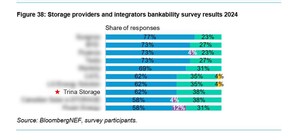Trinasolar Sees Growing Opportunity For Hybrid Solar Projects in Southeast Asia
KUALA LUMPUR, Malaysia, Aug. 14, 2024 /PRNewswire/ -- Trinasolar, a global leader in smart photovoltaic (PV) and energy storage solutions, is poised to leverage the success of Malaysia's largest hybrid solar project to expand similar initiatives across Southeast Asia, recognizing substantial potential in the region.
In Southeast Asia, rapid economic development and increasing energy demands are often coupled with limited land availability. Floating solar presents an attractive solution by generating clean energy without using valuable land space. Additionally, floating solar installations can reduce water evaporation from reservoirs and benefit from higher production efficiencies due to the cooling effect of water. However, engineering and construction costs are usually higher than those of a round-mounted solar farm. Hence, hybrid solar farms present the best of both worlds for grid-scale solar farms.
One such successful application is the 100MWac hybrid solar farm - owned and developed by Malaysian company Cypark Resources Berhad (Cypark Resources) – is located in Merchang, a coastal town in Malaysia's northeastern state of Terengganu. Commercially operational (COD) on 9 June, this innovative plant is projected to generate enough clean energy to offset 202,024 tonnes of CO2 emissions annually.
As stated by Dato' Ami Moris, Executive Chair of Cypark Resources Berhad, "This is Malaysia's largest hybrid solar power plant consist of 35MW floating solar panels on the water surface and 65MW solar panels installed on land. This demonstrates Cypark's ability to integrate solar power plant development with the natural environment of Terengganu, which is susceptible to flooding."
Elva Wang, Head of Southeast Asia at Trinasolar commented, "This complex project's successful operation is a testament to its design and implementation. We foresee significant opportunities in Southeast Asia for large-scale hybrid solar projects, integrating both floating and ground-mounted installations. We look forward to continuing our collaboration with Cypark Resources and appreciate their trust in Trinasolar for this ambitious project aligns with Malaysia's goal of achieving a 70% renewable energy mix by 2050."
The versatility of Trinasolar's Vertex modules was crucial for the project's success. The 35MW floating solar segment, situated on a lake near the sea, faces high humidity and salt-laden conditions. The Vertex modules' dual-glass design ensures resistance to harsh environments. TÜV Rheinland, a global leader in independent testing, has recognized the Vertex modules for their performance under these challenging coastal conditions.
The bifacial nature of the Vertex modules allows for sunlight capture from both sides, enhancing energy generation. This feature is particularly beneficial for the ground-mounted system, where the white sandy soil creates a strong albedo effect, reflecting light to the module's underside.
"This project is a clear demonstration of the potential for hybrid solar projects in the region," Wang concluded. "We look forward to driving more such initiatives and contributing to Southeast Asia's renewable energy ambitions."
SOURCE Trina Solar Energy Development Pte. Ltd.






Share this article